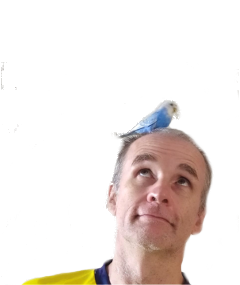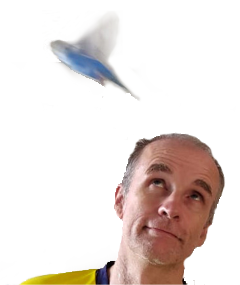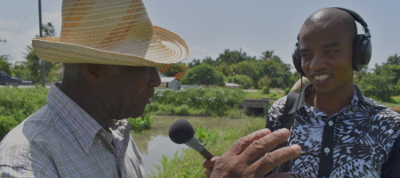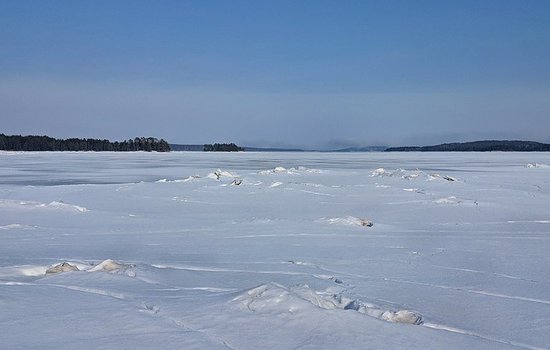
Ice, Corn and Quajimajatuqangit: tips for eLearning inspired by the North (and South)
Oct. 1, 2023
The hamlet of Palma Real is a dozen of so adobe houses clustered in the jungle of Veracruz. It is (or was, when I last visited) unreachable by vehicle. The inhabitants, all Nahuatl-speaking indigenous, were entirely self-sufficient. I visited a friend of mine there soon after the winter corn harvest, when the loft of his house was stuffed full of corn cobs. Held in place by a wicker ceiling just inches above our heads and blackened by soot from the family fire was all the corn the family would eat for the next six months. I remember staring up in amazement, my friend amused at my reaction. Until now, my concept of "eating" consisted of a vague network of abstractions: meal times, grocery stores, recipes, flavours. But here it was now, an embodied, circumscribed, collection of things. In that moment, "eating" becamse countable, particular, and somewhat pungent.

In the 1960s, a team of cognitive psychologists compared how children in rural Mexico and the suburban US learnt about the concept of similarity (Maccoby & Modiano, 1966). They showed children of different age groups lists of everyday objects and asked them to explain how they were alike or different. They found that the youngest children in both countries were more likely to find differences than similarities, and their criteria were almost always rooted in concrete perceptions: colour, taste, shape etc. The older children in the United States, however, were better at finding similarities, and they now used more abstract concepts such as "goodness", "badness" or the uses to which the objects could be put. Their Mexican counterparts, meanwhile, persisted in relying on concrete attributes, and remained more inclined to find difference than similarity.
You might think suburban American children are more sophisticated, more able thinkers. Not at all, said the researchers. Instead, they reflect cultural and environmental adaptation. Rural Mexican children are rarely exposed to deep layers of abstraction. Instead, they live in close proximity to natural objects -- the seeds they plant, the beans they eat, the weather that guides the course of their day, the hazards and dangers they must avoid. In this environment, observation is at a premium. The distinctions they learn to make between objects grow ever more precise -- from variations in the taste of two beans to blemishes on the surface to misshapen husks. The American child, by contrast "is a member of a culture that prides itself on its power over nature." They are "taught to abstract, to manipulate concepts, to control things." Abstraction comes at a cost:
I was recently asked how I would devise an elearning strategy for youth in the north of Canada and I recalled my experience with my Nahuatl friend's corn. Do Inuit and other northern inhabitants, living close to the land and far from urban centers learn through the same concrete channels as rural Mexicans? Another study with Iñupiaq children, contemporary with and using the same methodology as the first, found that to some extent they do, albeit with an important difference which I will discuss below. But even more convincing, for me, are the childhood recollections an Inuit hunter and illustrator from Arviat, Nunavut called Donald Uluadluak. I found his stories in a collection of interviews with Inuit Elders published about twenty years titled Inuit Quajimajatuqangit: What Inuit Have Always Known to be True (Karetak et al., 2017).
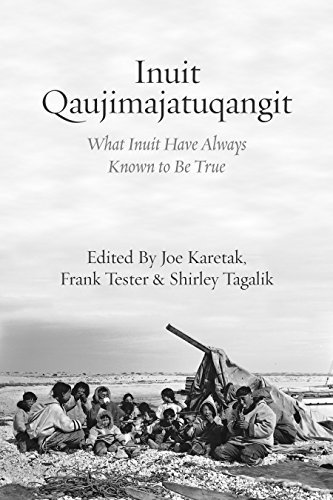
Uluadluak's recollections brim with the concrete: trees, frozen lakes glistening in the sun, hills, rocks, place names, a sled full of food. He tells a particularly moving story of a long sled ride he took with his mother as a young child, dozing as "brightly smiling" branches passed over head. He observes passing objects with the attention a city child might give to rest stops and roadside attractions. They take a break beside a "special rock", that "looked almost square."(Karetak et al., 2017, p. 148) Years later, as an adult he returns to look for that rock. His excitement is palpable, so too his disappointment when he discovers it is much smaller than he remembers.
Uluadluak's childhood education was similarly concrete. He calls it pilimmaksarniq, the process of "becoming able", or "when you are training anyone using concrete materials and tools that children can feel and practice with." He recounts the sensation of pushing in a handle to set a fox trap for the first time, of jumping from wobbling ice floe to ice floe, and learning to use a gun. His grandparents taught him by examples, that he was expected to follow. In fact, the editors of the book tell us in the introduction, perception and the senses are the key to learning even when learning about the abstract, such as the interconnections between human beings and the environment they depend on for survival.
This style of physical, perceptual learning forms part of a world view known today as Inuit Qaujimajatuqangit, which the interviews in the book capture vividly. What lessons can Qaujimajatugangit hold for elearning? There is already a wealth of literature on its role in northern schools. It even forms the basis of the Nunavut government's official curriculum framework (Inuit Qaujimajatuqangit Education Framekwork for Nunavut Curriculum, 2007). I'm not an expert, so I have little to add to this, but based on my own experience working with rural learners in Latin America, one simple thing jumps out at me immediately: the need to be concrete instead of abstract.
Close your eyes and repeat a word. Does it immediately conjure an image or stir a feeling? If so it is a good solid concrete word. On the other hand, if it sounds like it would be more comfortable on a government website, a Power Point presentation, or a LinkedIn post, it probably isn't. Prefer the concrete language to the LinkedIn jargon. Equally, avoid generalizations in favour of specific illustrations. To make an observation general or universal, use more illustrations. But you don't always need to be all-encompassing. Udlualak was reluctant to speak for other people or communities. His testimony was what he experienced. It was up to us to draw more general conclusions.
Let's imagine we're creating an online course in job searching. One module explains how to list skills on a resume. It may seem like "skills" is pretty concrete, but not to everyone. An acquaintance of mine who teaches job searching to immigrants tells me that the idea of listing your abilities, independently of each other, and independent of the context in which they might be used, is not natural in every culture. In some cultures (including her own), she says, it is even seen as presumptuous and boastful. In our case, we can't avoid using the word skill, but we can accompany it at every turn with similes: "things we are good at", "things we can do well", "activities we have learnt to do", "the abilities we have that are useful to other people."
We can go further, by offering examples of skills that would seem useful or relevant to our particular learners. Even better, we can explain how and when these skills might be used. Best of all, we can demonstrate how to identify skills with realistic examples. We can invent a character, use somebody famous or somebody our learners would know, and walk them through the process of thinking about what they are good at, what they can do that is useful, what they can do that not everyone else can.

A course that works at such a concrete level might sound somewhat sterile, even constricting. How can learning be transferable if everything is so specific and contingent? However, if the material is presented and ordered (I stopped myself from writing "sequenced" here!) correctly, I believe your learners will discover the abstractions for themselves. Leave spaces, questions to ponder, suggestions of how different illustrations might be related to each other. At these moments, abstractions will bloom naturally, in the same way lessons about the interconnections between all living things were learnt by Inuit children simply watching their parents work.
And teaching in this way can actually be more engaging and exciting, rather than less. A principle of Inuit Qaujimajatuqangit is that learning is conveyed with feeling, reciprocity, even joy. "Inuit teach to the hearts of their children and the learnt knowledge is conveyed to the head," said Udlualak, recalling the thrill of being given tasks to do, and receiving praise when he got them right (Karetak et al., 2017). He compared his grandparent's instruction to a passionate sermon in church.
That's a tough act to follow, but one way we might approximate the feeling is through story. It is enough to hear Udlualak's pleasure at listening to his grandmother's stories on long winter evenings to understand the role of storytelling in Inuit culture. Stories were the TV shows and TikTik videos of his generation. If videos and social media are valid tools for education, then stories should be too. And there is precedent for this. The pioneer of educational psychology, Jerome Bruner, argued that stories are crucial to meaning-making. They are the tool by which children relate their own lives to whatever it is they have learnt, even factual subjects such as science and math. In fact, he suggested that stories help resolve the tension between the cold, impersonal facts of science and the subjective needs of human beings, for whom correctness is less important than belonging.
We could add stories to our job search course by telling the personal history of our imaginary job hunter. Why is she looking for a job? What has she done so find one so far? How has her search progressed, and what else is going on in her life that is affected by, or affects, the search? What are the consequences if she doesn't find a job? Her story could be stretched out over several modules, so the learner doesn't discover her fate until they finish the course. It could even be interactive. The skills the learner chooses for the character change the course of her search, and her life. In whatever manner it is told, the story should be, in the words of Donald Udlualak, "interesting and alive."(Karetak et al., 2017)
I mentioned that the researchers in Alaska detected an important difference in how the Iñupiaq children responded to the categorization tasks compared to their suburban and Mexican peers. They found that when the Alaskan children compared objects based on function, they always used the passive voice -- "It is eaten. It is used for hunting" -- instead of the first or second person -- "I can eat it. You can use it for hunting" -- more typical of their age group (Greenfield et al., 1966). They concluded this was a cultural difference, the "subsumption" of the individual into the social group, necessary for sheer survival in a difficult environment. Indeed, within Inuit Qaujimajatugangit, community is paramount. Respect, maintaining harmony and cooperation are taught from a young age. The entire community contributes to teaching a child, and the child learns in order to contribute back to the community. Western concepts such as learning for individual gain, "getting ahead" and "personal branding" would seem utterly alien.

I think this sense of community can be easily replicated through elearning. Forums, group discussions, chats and projects all allow students to work together, encouraging and guiding each other and offering informal, implicit assessment. Under the Community of Inquiry Framework of instruction, developed originally at Athabaska University, these kinds of peer discussions are called Social Presence, and considered crucial to learning, for everyone (The Community of Inquiry, n.d.). Learning is based on language, and language is a social act. We understand when we speak and listen. Knowledge, meanwhile, is distributed. Nobody knows everything about a subject, and social presence makes this interdependence explicit.
We could apply social presence to our job search module, by adding a forum. Learners can upload their resumes, and their peers question them, attempting to tease out the skills that they themselves might not even be aware of. Of course, an online forum doesn't have the same urgent interdependence as a community working together to dry fish before the winter comes, but there is still a sense of shared purpose and feelings of reciprocity, especially if managed well by the facilitator.
It is tempting to create a checklist of Inuit Qaujimajatugangit learning principles (and the elearning industry loves its checklists!) but this risks fossilizing it. Every community and generation is different from each other, and today none will be as Donald Udlualuak remembers them from 60 years ago. In fact, the author and former policy analyst, Jaypetee Arnakak who helped defined Inuit Qaujimajatugangit two decades ago for the Nunavut government wrote that he and his co-workers:
deliberately tried to keep IQ [nuit Qaujimajatugangit] from becoming an official policy, knowing that separating IQ from the contemporary realities renders something that is profound, enriching and alive into something that meaningless, sterile, and awkwardly exclusionary (Arnakak, 2001).
A checklist might turn Inuit Qaujimajatugangit into the "dry nominalism" we were warned about at the beginning of this essay.
I think a better approach may simply be for an instructional designer to steep themselves in the spirit, the voice and language of their learners. There are worse places to start than reading the interviews with Donald Uluadluak and other Elders collected in the book Inuit Qaujimajatugangit. Even better would be to speak to them, other Elders, or their learners themselves. They could even use participatory design methodology to involve learners in the development of the course. Written with sensitivity and imagination, the course might capture that tangible, concrete feel, the joy for learning by doing and thrill of sharing with a community I found in Udlualuak's words.
Which, come to think of it, sounds like a pretty good course for anyone. Maybe the question shouldn't be, "how can we adapt an elearning course to Inuit Qaujimajatugangit?", but "how can Inuit Qaujimajatugangit inspire all elearning."
Arnakak, J. (2001, January 13). What is Inuit Qaujimajatuqangit? Canku Ota. http://www.cankuota.org/IssueHistory/Issues01/Co01132001/CO_01132001_Inuit.htm
Bruner, J. S. (Jerome S. (1996). The culture of education. Cambridge, MA. : Harvard University Press. http://archive.org/details/cultureofeducati0000brun
Greenfield, P., Reich, L., & Olver, R. (1966). On Culture and Equivalence: II. In J. Bruner (Ed.), Studies in cognitive growth: A collaboration at the Center for Cognitive Studies. New York : John Wiley. http://archive.org/details/studiesincogniti0000unse_p8l8
Inuit Qaujimajatuqangit Education Framekwork for Nunavut Curriculum. (2007). Nunavut Department of Education. https://www.gov.nu.ca/sites/default/files/files/Inuit%20Qaujimajatuqangit%20ENG.pdf
Karetak, J., Tester, F., & Tagalik, S. (Eds.). (n.d.). Inuit Qaujimajatuqangit: What Inuit Have Always Known to Be True. Retrieved September 11, 2023, from https://fernwoodpublishing.ca/book/inuit-qaujimajatuqangit
Maccoby, M., & Modiano, N. (1966). On Culture and Equivalence: I. In J. Bruner (Ed.), Studies in cognitive growth: A collaboration at the Center for Cognitive Studies. New York : John Wiley. http://archive.org/details/studiesincogniti0000unse_p8l8
The Community of Inquiry: About The Framework. (n.d.). The Community of Inquiry. Retrieved September 11, 2023, from https://www.thecommunityofinquiry.org/coi
